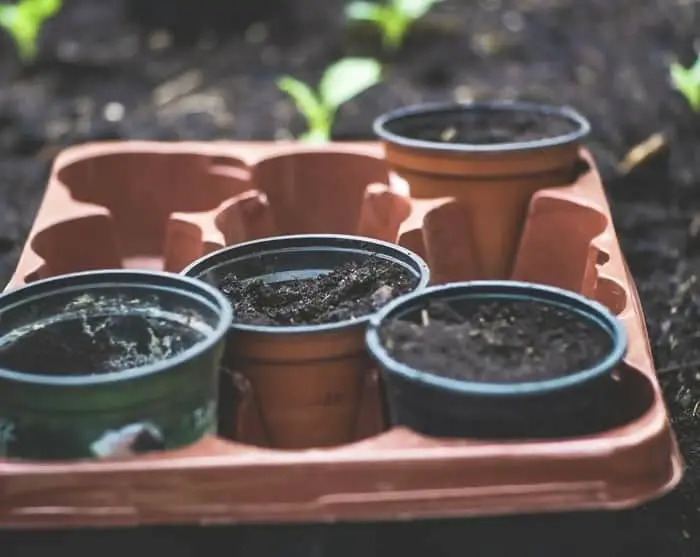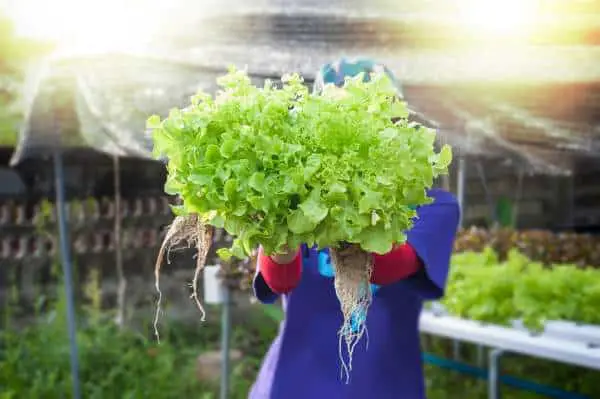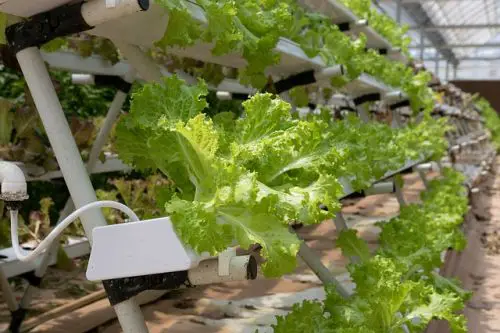Hydroponic gardening seems like it could be a good choice for gardening. Quicker plant growth and better plant production, who could ask for more? I know though, that it requires some sort of investment, so I started wondering if it was worth it.
Is hydroponic gardening cost-effective? Cost breakdown: Yes, hydroponic gardening is cost-effective but you must understand that it requires an initial investment. Once you’re up and running, you can expect to see quicker plant growth and better plant production compared to plants in normal soil.
Now, that you know hydroponic gardening can be cost-effective, lets’ take a look at the specifics of the system so you know just what you’re getting into.
What is Hydroponics?
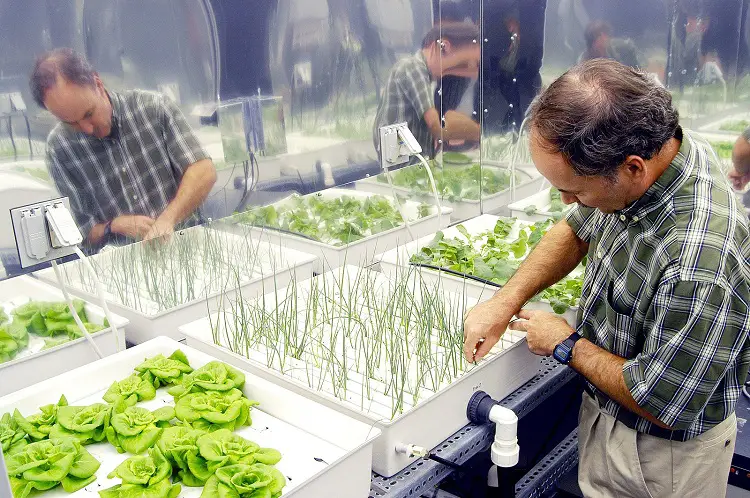
Before you jump in and start spending money, it’s important to understand exactly what hydroponics is so you know where your money is going.
Hydroponics is a way to grow plants without soil. It uses a mineral-based nutrient solution to give plants what they need to grow. Instead of soil, hydroponics generally use one of the following mediums:
- Perlite
- Rockwool
- Clay pellets
- Peat moss
- Vermiculite
The idea is that because the plant’s roots come into direct contact with the nutrients necessary for growth, the plant can focus more on growing up and producing fruit rather than expanding its root system to reach what it needs.
Hydroponics has a number of benefits including better growth compared to plants that don’t use the system, sometimes up to 25% quicker growth. Plants in a hydroponic system also generally produce up to 30% more than plants in a regular growth medium like soil.
Another benefit is that a hydroponic system uses less water than a regular garden because it’s a closed system. This means there is less evaporation.
Finally, hydroponics is good for the environment (as long as you don’t dump your water, but we’ll get into that later). Hydroponics reduces waste and pollution from soil runoff, which happens in a regular garden.
Just like with any new venture, along with the benefits come the disadvantages. One disadvantage is that it’s more of a time commitment than just planting some things in the dirt and watering them every few days.
A hydroponic system requires you to take the time to set it up initially. Once it’s set up, you have to monitor the nutrient levels of your water on a very regular basis. At some point, this may become more automated but in the beginning, it definitely requires your attention.
Another disadvantage and the crux of this article is that a hydroponic system will obviously cost you more than just buying some soil and plants and throwing them together. The saying “dirt cheap” exists for a reason. A hydroponic system doesn’t use dirt and it doesn’t fall under that saying either.
Equipment Involved With Hydroponics
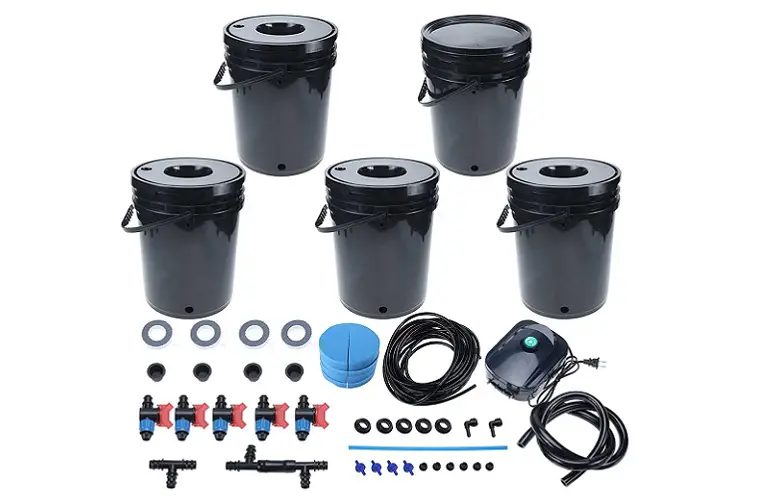
The best way to figure out just how much you’re going to invest in your hydroponic system is to learn about the equipment involved with the system.
The good news is there are a number of different hydroponic systems available and you can pick one based on your budget. Including the system, here’s a look at what you need to successfully start a hydroponic garden:
- Hydroponics system
- Hydroponic nutrients
- Inert medium
- Light source
- Plants
Hydroponic system
A hydroponic system holds the water or other inert medium and provides a place for the plant to grow.
Within hydroponic systems, there are two categories: solution (or liquid) culture and aggregate culture. With a solution system, the plant grows right in your hydroponic solution. An aggregate system involves a medium like gravel or sand and the roots grow into the medium.
There are a number of different hydroponic systems for you to choose from based on your budget, how much you want to grow, and the space you have available.
Here’s a list of the various hydroponic systems:
- Deepwater culture (reservoir method)
- Nutrient film technique
- Aeroponics
- Wicking
- Ebb & Flow (flood and drain system)
- Drip system
Deepwater culture
A deep water culture hydroponic system is also known as the reservoir method. It’s one of the easiest methods for growing plants hydroponically so it’s a good choice for beginners.
In this system, the roots are suspended in the nutrient solution and an aquarium air pump provides oxygen to the nutrient solution to keep the plant roots from drowning.
A major benefit to this system is that there are no parts that may clog, although you’ll need to be sure light doesn’t get into the closed part of the system. If light gets in, it can cause algae to grow, a big no-no for growing.
Here’s a great deep water culture hydroponic system on Amazon which is perfect for beginners and intermediate growers as it takes the hassle out of building your own set-up, saving you hours! It has room for 36 plants and tends to suit leafy greens.
If you’re looking for a deep water culture hydroponic system that’s better for plants with deeper roots and want to grow more than leafy greens you can’t go wrong with this kit from Amazon, this kit is modular which will allow you to quickly expand or reduce the size of your set-up to suit any room.
Nutrient film technique
With the nutrient film technique or NFT of hydroponic gardening, a continuous flow of nutrient solution runs over your plant’s roots. The solution is kept on a tilt so the force of gravity keeps it flowing.
This system is efficient because the plants absorb more oxygen from the air than from the nutrient solution. This results in a fast rate of growth for the plant.
Here’s a great NFT system on Amazon with plenty of space for new crops! Be aware though, this product doesn’t come with the reservoir shown in the photo.
Aeroponics
In the aeroponics method of hydroponic gardening, the roots are suspended in air and misted with the nutrient solution. Either a fine spray nozzle or a pond fogger does the misting.
The AeroGarden is a type of aeroponic system and is a great starting point for gardeners new to hydroponic gardening because it comes with everything you need.
Here’s an AeroGarden on Amazon. This one falls in the middle of AeroGardens as far as size goes. Remember, also, the AeroGarden includes everything you need so you won’t need plants or nutrient solutions if you choose this route.
Wicking
Wicking involves a material, such as cotton, surrounded by your growth medium. The end of the material that is not in the growth medium is placed in the nutrient solution and then the solution is “wicked” to the root of your plants.
This is one of the easiest hydroponic methods and it will save you money because it’s also one of the lowest cost methods.
It’s more of a do-it-yourself setup, so you’ll need your wicking material as well as pots and a medium. You can get 50 feet of wicking cord on Amazon for the price of a couple of coffees!
Ebb & Flow
The ebb & flow method is also known as a flood and drain system in hydroponic gardening. With this method, you flood the area where you’re growing your plants with the nutrient solution at certain intervals.
Slowly, the nutrient solution drains back into a reservoir. This process just happens over and over again and is regulated by a timer, which is hooked to a pump.
Here’s an ebb & flow system on Amazon. It has room for 15 plants and is a complete setup including everything you need to get started, except seeds.
Drip system
A drip system in hydroponic gardening provides a slow flow of nutrient solution to your medium.
This system does have the downfall of fairly frequent clogging. This happens because particles from the nutrients build up in the part of the system that puts out the nutrient solution, but it is affordable.
Hydroponic nutrients
Your nutrient solution is a mix of primary, secondary, and micronutrients designed specifically for hydroponics. These nutrients are not the same that are used in regular fertilizer for plants growing in soil.
Some of the nutrients you might see in a hydroponic solution are calcium, nitrate, nitrogen, phosphorous acid, potash, magnesium, boron, zinc, and iron.
Here’s a complete pack of nutrients you’ll need to make your hydroponic solution to maximize growth potential in your setup. This pack of three includes the primary, secondary, and micronutrients required in hydroponics.
The bottles only hold a quart of the solution but keep in mind you mix just small quantities with water to make your nutrient solution.
Inert medium
The inert medium obviously provides a place for your plants to grow. Inert means the material doesn’t break down quickly. This helps supply the nutrients to the plant.
Here’s a table that shows some ideas for medium and some cost estimates.
| Medium | Indicative cost | Amazon Link |
| Rockwool | $8-15/100 cubes | Amazon Link |
| Clay rocks | $10-15/2 lb bag | Amazon Link |
| Coconut fiber/chips | $20-25/10 lb bag | Amazon Link |
| Perlite | $10-15/8 qt bag | Amazon Link |
| Sand | $4-8/5 lb bag | Amazon Link |
| Vermiculite | $15-20/8 qt bag | Amazon Link |
The best growing medium for you depends on your system. Any of them should work fine with drip and NFT systems, just watch for the medium getting too soggy.
Aeroponic and deepwater culture systems don’t use much of a medium anyway. An ebb & flow system does best with mediums that don’t float, so stay away from perlite and vermiculite and you need a medium that absorbs moisture easily for a wick system.
Light
If you’re growing your plants hydroponically outside, you may not need light. If the system is inside, you’ll need a light source to provide one of the necessary ingredients for growth.
Some popular light choices are:
- Metal halide
- High-pressure sodium bulbs
- LEDs
- High-output fluorescents
- Compact fluorescents
Plants
You can grow just about anything you want hydroponically, but different types of plants do better in a solution system while others are better suited for an aggregate system.
This comparison chart gives you an idea of which system is best for certain plants.
| Solution System | Aggregate System |
| Lettuce Spinach Radishes Herbs | Beets Squash Cucumbers |
Miscellaneous costs
There are some miscellaneous costs you’ll run into in hydroponic gardening.
One that adds up quickly is electricity. Most hydroponic systems run on electricity, so you have to consider your electrical costs. The average cost of electricity in the United States is 12-cents per kilowatt-hour.
What you grow determines how much you’ll have to use your lights but you can expect to run your lights for at least 6-8 hours.
Since a few hours without power will dry out and kill your plants some people buy a generator to supply backup power in case of an outage. Here’s a small generator on Amazon. If you’re planning on just having a small home system a generator isn’t worth the cost but it can be a lifesaver if you’re planning on going away or wanting to run a large-scale hydroponic system.
A very small miscellaneous cost worth much more than the actual amount is test strips or a digital pen to check the potential hydrogen or pH level of your water and a testing pen to check the electrical conductivity or EC levels.
The levels in your nutrient solution will make or break your hydroponic garden. You’ll very quickly see the effects on your garden if the levels in your water are off.
Ways to Save With Hydroponic Gardening
If you want to jump into hydroponic gardening but the cost is an issue, there are ways you can save money.
Pick the best system
To start with, figure out which system gives you the most bang for your buck. Buy the system that fits into your budget and start small if you have to, you can expand later.
While we talked about many hydroponic gardening kits available online, if you’re really trying to save money you can make one yourself. Obviously, a less technical one is the best choice if you’re going to make a hydroponic gardening system yourself.
Here are some of the less complicated systems that should allow for you to put it together yourself:
- Deepwater culture setup
- Nutrient film technique
- Wicking
- Drip system
You should see quicker production and growth with a hydroponic system as well as use less water.
This means you’ll be saving money anyway with more production and less water, but another step you can take to save is to recycle your hydroponic water.
Recycling your water
Recycling your hydroponic water can cut down greatly on how much water you use. You can’t just reuse your water without disinfecting it first. If you don’t disinfect the water, you run the risk of infecting your plants with any bacteria or viruses the water has picked up.
While there are various ways to recycle your water, the three most common are pasteurization, ozonation, and UV disinfection.
Yes, the recycling systems cost you a bit at first but once you’re able to just cycle your water over and over again, you’ll make up the difference.
Here’s a look at the different disinfecting methods.
Pasteurization
The process of pasteurization uses a heat source to rapidly heat the water and then cool it to kill bacteria and viruses.
Ozonation
During ozonation, the water is infused with ozone. Ozone is a natural gas found in the ozone layer (makes sense, right), which is created by the ultraviolet radiation from the sun. It’s actually just three oxygen atoms combined together.
In your garden, an ozone generator creates the ozone that is used to disinfect the water.
UV disinfection
UV disinfection uses high-pressure ultraviolet lamps to destroy the bacteria and viruses in the water. The UV rays zap the water as it passes through a radiation chamber.
If there’s no way you can spend the extra money on one of the disinfecting systems, you can still recycle your hydroponic water by using it on other house plants. You obviously won’t save as much money because you’re not fully recycling the water but you might just get some really good growth out of your other plants.
It’s best to use the recycled water on plants in pots rather than directly in the ground because the nutrient levels in the water can have a negative effect on the environment if they’re too high.
Save on groceries
If you don’t already have a garden, obviously growing your own herbs and vegetables will save you money when it comes to grocery shopping.
Ideally, you’ll also be doing your hydroponic gardening indoors. This means you’ll be able to grow what you want no matter the time of year, which means you won’t have to pay out-of-season prices for your produce at the store.
Since you’re probably somewhat limited on space, your best bet is to make a list of the most expensive fruits, vegetables, and herbs you enjoy. Put those at the top of your list of what to grow hydroponically.
So, hydroponic gardening is cost-effective, you just have to have the initial money available to get your system up and running.

